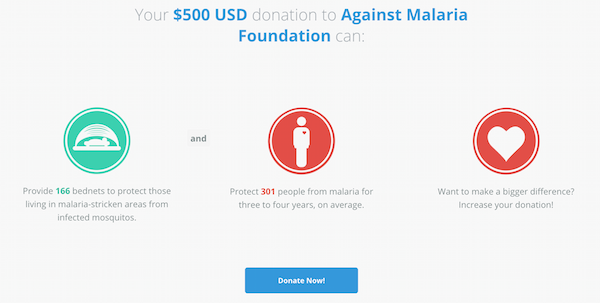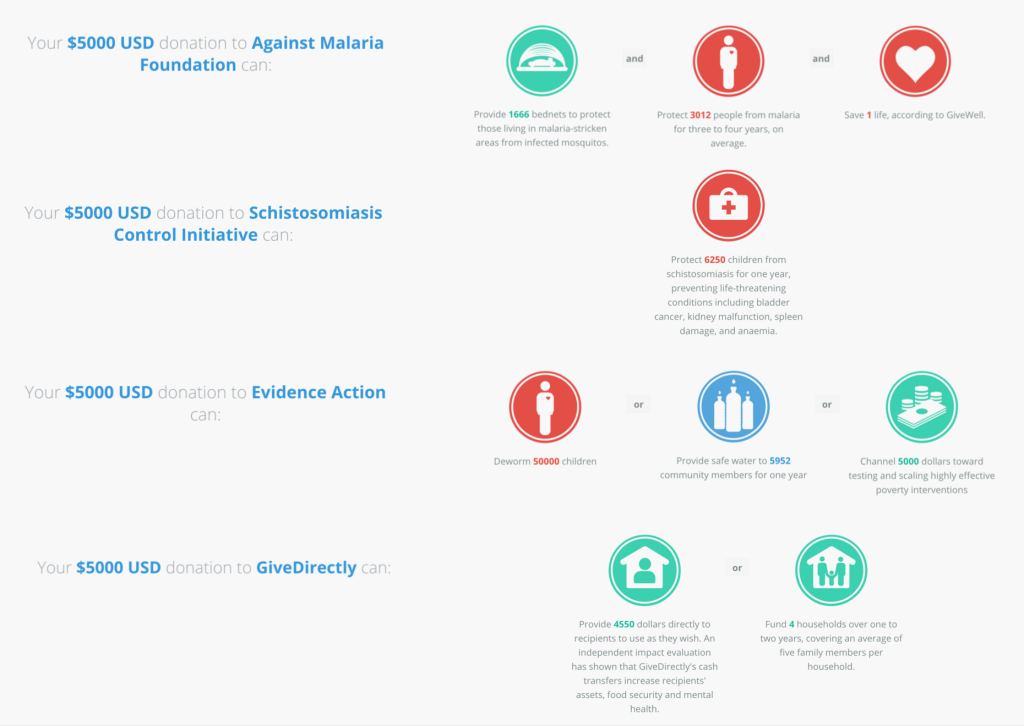Recommendations for donations: 2015-16 edition
Sorry this post arrives so late in the year, probably after most of you have already made your charitable year end donations.  However, I’m following my own advice — see my final point below. Â
Are you fortunate enough to be able to donate resources to others this year?  If so, here are some ideas for how to maximize the effects of your donation.  Some of these are suggestions for specific charities.  But whatever causes and charities are most important to you, there are ways to make your giving more effective — and some of these suggestions apply to all donations.
Do you want your donation to have a large, empirically proven impact?
I’ve talked before about how much I admire GiveWell and Innovations for Poverty Action, which are effectivist organizations to the core — both organizations do empirical, in-depth evaluations of the impact of charities.  This year, the press is taking notice as well; Vox and Wall Street Journal columnist Jason Zweig both wrote about how these organizations help your charity dollars go farther.
GiveWell once again has published their annual top charities list, with the four charities that they’ve determined give the most impact per donation. I recommend following GiveWell’s donation allocation suggestion:
For those seeking our recommended allocation, we simply recommend giving to the top-ranked charity on the list, which is AMF.
Another organization, The Life You Can Save, has an overlapping top charities list — along with a very useful Impact Calculator that lets you see the impact of a donation to each charity.  I don’t endorse this organization as strongly as the others, because I don’t know as much about it (it was founded by ethicist Peter Singer; I don’t believe it does the same degree of rigorous evaluations as the two sites above, but it does depend on some outside evaluations), but a number of these charities have been endorsed by the other two sites, and the Impact Calculator is great.
For instance, if you’re considering donating $500, you can see the impact on GiveWell’s top-rated Against Malaria Foundation:
If you have more money to donate — or just want to understand what the charity does with a bigger pot of donors’ gifts — you can increase the amount in the calculator.  Here’s what the top charities on GiveWell’s list could each do with $5000 of donations:
Want to science the shit out of future nonprofit work?Â
(as my favorite fictional astronaut of the year, Mark Watney, would say)
If you want to help make nonprofits more effective and to continue this work empirically evaluating of charities, I strongly recommend donating directly to IPA. Â
GiveWell and other charity evaluators draw on their research; so do government policy makers. Â These folks are doing the basic field research necessary to evaluate charities. Â Donate here.
You can also donate to GiveWell — one great way they offer to donate is to add an additional 10% onto any donation you make to their top charities via their site, or you can donate directly.
Want help evaluating charities for a wider set of causes?
The above sites are great, but one limitation is that they only evaluate a narrow set of causes.  What if you want to donate to other causes?  (I myself also donate to other causes — including things like long-term health and science research, which are important investments, but much harder to assess the impact of.)
You can research other charities with three big charity evaluator watchdogs: Charity Navigator, CharityWatch, and the Better Business Bureau Wise Giving Alliance. As I have cautioned before, these sites all focus overly on financial measures (understandably, because there is no good universal effectiveness metric).  This is risky, because effective organizations can vary greatly in dimensions such as the financial overhead that they require to get things done.  But it can still be worth checking these databases for any big red flags against lesser known organizations — keeping in mind that good organizations might sometimes not pass every single test, and some ineffective organizations might get high marks. Â
Another tool I’ve found useful is Philanthropedia, which gathers expert opinions on a wide variety of charitable causes.  The opinions usually aren’t based directly on empirical impact assessment, and many experts are biased, but keeping that in mind, I’ve found it very helpful to read a bunch of experts talking about which organizations they like and why.  (I blogged about this site before when it was just starting; it’s expanded a lot since then.)
The NYT has more tips for savvy donors if you want to do more homework.Â
Want to donate to disaster relief?
As I’ve discussed before, there are some additional causes I believe in investing in besides the ones that have the most immediate and measurable impact, including a safety net following a disaster.  Edit: This is an area where GiveWell advises against giving, and I agree that much disaster relief work is not very effective, but I still prefer having an expensive safety net to none.
Last year I recommended against donating to American Red Cross due to major concerns raised by Propublica and NPR.  I haven’t had time to follow up in any detail, but it looks to me like the ARC is still fighting transparency and oversight and failing stunningly at effectiveness in at least some areas.  Note:  this doesn’t mean that there’s nothing the ARC does well, nor that it might not be the most effective organization at some tasks.  I’m just pointing out the big red flags that mean that when considering alternatives, I still do not endorse the American Red Cross.
I do endorse Oxfam and Doctors Without Borders (MSF), which I’ve endorsed before. Doctors Without Borders has been rated well by GiveWell, and Oxfam makes this year’s The Life You Can Save’s top charities list. (These are certainly not equivalent organizations; Oxfam is closes in mission to Red Cross, but not identical.)
Edit: Propublica encourages researching smaller local organizations after a disaster; these can be more effective at avoiding some of the pitfalls the American Red Cross encountered in Haiti.
Edit 2:Â Following a disaster, there’s usually an immediate outpouring of donations, but what’s most needed are long-term funds for rebuilding and recovery — made to organizations that plan to stick around. Â Research organizations carefully and don’t earmark your funds.
Want to donate to family planning?
Family planning has a high impact on poverty as well as overall population health and welfare, and I’ve blogged about it in the past. Many US citizens focus on Planned Parenthood in the US, which is a good domestic organization, but I’ve also turned up a number of highly rated organizations with international impact in the past.  In past years, I ended up donating to Pathfinder International after further personal research.
The Life You Can Save recommends Population Services International.
Edit: While I do think this cause is very important, this year I’m probably going to invest more money in GiveWell/IPA-endorsed causes to address poverty and health issues, because I believe that those have even higher impact.  I may separately donate a smaller amount to Planned Parenthood under my different mental category of “things I want to exist near me.” I still endorse the above charities, but felt it was worth clarifying my own thinking on the matter here, in case it helps anyone else in their own prioritization.
Want to make your money go farther — toward any cause?
Don’t earmark funds toward particular uses.  Just donate to an organization and letting them use the money wherever it’s most needed. Otherwise, organizations often end up with more money than they can immediately use for the most publicized or sexy portion of their cause, but not enough money to sustain other necessary parts of their work.  (One of my favorite blogs that used to talk about why this is a bad idea, Good Intentions Are Not Enough, has sadly folded — anyone else have a great citation?)
Check how your charity prefers to receive funds.  Usually, if donating a large amount ($1000 or more), you’ll want to donate via check if possible, because credit card, paypal, and other donation services all take a big bite out of your donation.  (See more information about the fees on GiveWell’s site.)Â
Don’t forget about matching programs, especially from your employer — it can double, or otherwise greatly increase, the amount of money the charity ends up getting!
Stop charities from spamming you — get them to stop sending you mail, or selling your address.  (Okay, that one is mostly for your own sanity!  But it hopefully saves them some wasted resources, too.)
Want to donate time rather than money?
I’ve blogged in the past about sites that help you use your skills for good. Â (A few links may be dead, but some of the biggest sites are still working.)
Do what you can, and feel good about what you do.
This one is a biggie for me: Don’t let the perfect be the enemy of the good. Â
If you don’t have the resources to extensively research charities, if you can only donate via credit card, if you didn’t ask your employer for matching funds last year when you could have, if you have donated to a charity that turns out to have a less than stellar record — don’t beat yourself up!  Instead, feel good for having done something with some positive impact.  Giving some time or money to a cause is almost certainly better than giving nothing because you’re too uncertain where or how best to give (a mistake I’ve made in the past).  Be kind to yourself as well as to others, this giving season.
—-
Thanks for listening, and for any feedback you might have on effective donations! Â Feel free to share your own tips. Â I will try to share an updated version of this advice again next year, earlier in the giving season. :)


